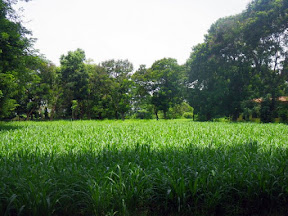We visited an outdoor center for living traditions of art and culture of South India: Dakshina Chitra. There were houses recreated in traditional styles from different locations in Tamil Nadu, the state in which Chennai is located.

The group in a traditional artisan’s house

Cultural artifacts from the Marutham area of Tamil Nadu.

More traditional-style homes from Tamil Nadu
There were also some amazing artists there selling their artwork. There were jewelers, palm-leaf carvers, painters, weavers, and even a glass blower.



A small shrine
They also had a traditional Indian puppet show (though we only saw about 2 minutes of it before the power went out, stopping the show).

They had fortune tellers as well, which were a big hit.

One was a fortune-telling parrot.

***
We also visited a stud farm outside Chennai.

Many years ago when Dr. Subbiah and his wife, Ruby, both worked at Madras Veterinary College, they visited this farm frequently. Ruby said they got a fair few of these horses at necropsy every week – mostly foals with rhodococcus. However, the overall health on this farm has improved immensely. There are about 700 horses, with 300 of them breeding mares, on the farm at one time. The farm encompasses over 300 acres and is the largest in Asia. The farm and all the horses are owned by one man, who is so wealthy that he literally lives in a palace. We didn’t meet him.
We did meet Dr. Kumar, who is the head veterinarian on the farm. He showed us the farm and told us its history.

Left to right: Dr. Kumar, Dr. Subbiah
The farm is 25 years old and both imports and exports horses all over the world. It only imports horses from the US though, due to the difficulty (red tape) in exporting livestock to the US. They only breed race horses, and sell them when they reach the age of 2.



When these horses retire, they often come back to the farm. Horses that fail to become race horses or cannot breed are used as government horses. Apparently almost every police horse you see in southern India is from this farm.
Most of the rules regarding race horses are the same as in the US: only natural service is allowed, all horses have a January 1 birthday, etc. One thing they do that I thought was interesting was that they put horses that will foal soon in an artificially dark and quiet environment so that they will give birth earlier in the day (10pm as opposed to 1am) so that they can have more staff available if there is a dystocia or other problem. They said that on their farm dystocia is really rare, but if it happens, 90% of the time it’s due to breech presentations.
They don’t have many illnesses on the farm in general, and totally different ones compared to the US. On this farm though, they don’t screen for diseases in their static horse population, Dr. Kumar said, but instead they just give prophylactics. They do have trypanosomes here, so they give prophylactics to the horses every 3 months. They don’t have CEM in the southern part of india, where in the north, it’s a problem. They prevent most incoming diseases by mandating a 30 day quarantine on all horses and screen all incoming horses for diseases. EIA is a potential issue, and they screen for it during the quarantine period.
They produce some of the horse feed on the farm.


While we were at the farm, we got to visit several different barns. We saw new foals with their mothers, studs, yearlings, and a group of maiden mares who were about 4 months pregnant.


On the outside of some of the barns was this symbol. It’s a sort of evil eye, and is traditionally drawn to ward off evil. It’s more of a good luck symbol, I suppose, and it seems to be working.

Alex, Amber, and Wallace with one of the studs, Always A Rainbow

Amber and Carrie with another stud

This is me with a group of yearlings. They were very friendly and curious and flocked over to the our group. (however, one did try to eat my hair...)

Here is a group of the maiden mares.




On the way out of the farm, we came across a group of water buffalo.
Next: The most boring conference ever, pool party at the US consulate’s house st. thomas’ basilica, & murugan hindu shrine.
No comments:
Post a Comment